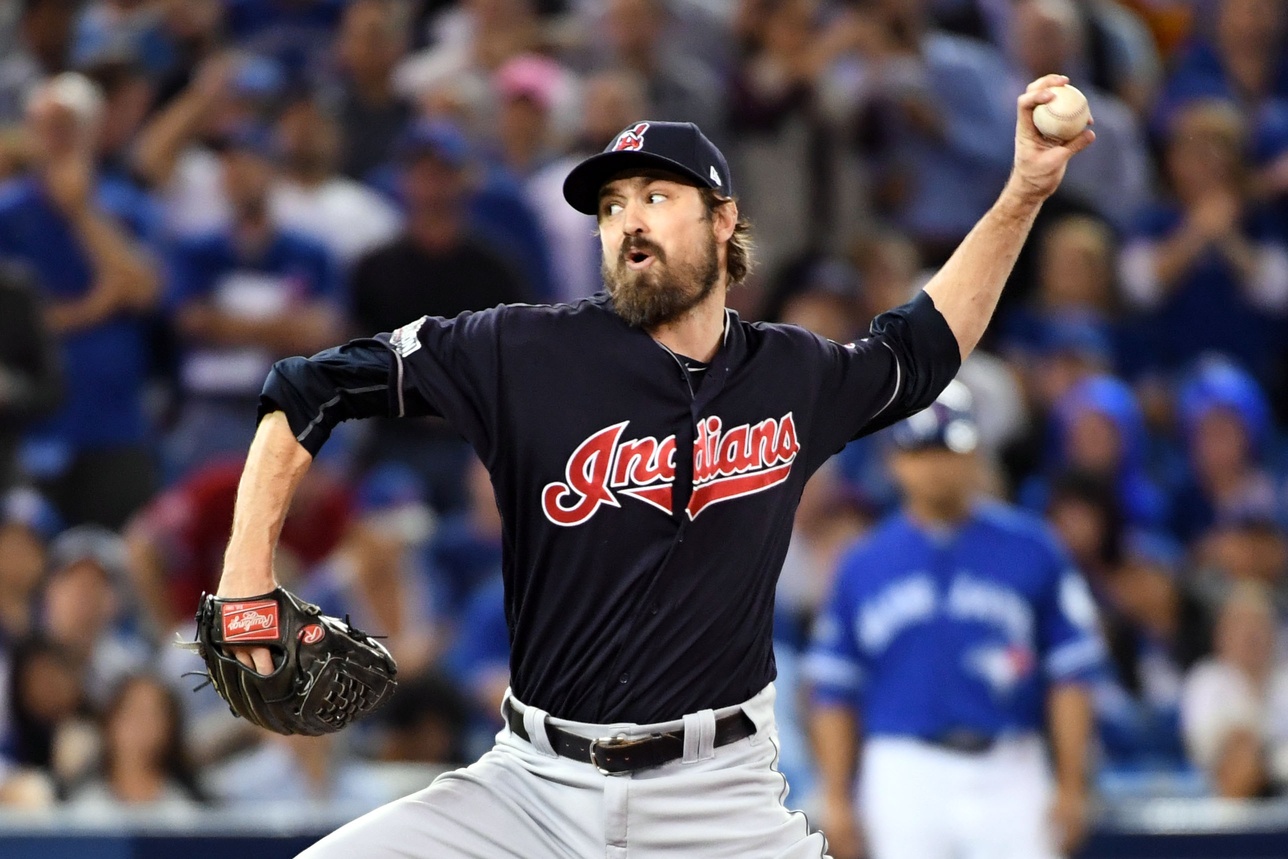The talk of this year’s postseason has undoubtedly been Andrew Miller of the World Series-bound Cleveland Indians. The Tribe gave up four prospects, including the highly-touted duo of Justus Sheffield and Clint Frazier, to bring Miller in to reinforce their relief corps prior to the trade deadline this past summer. Rather than install his best reliever in a typical “closer” role, manage Terry Francona instead played the numbers with Miller’s usage, deploying him when the stakes were highest in late-game situations, regardless of whether it was the ninth inning or the sixth. Miller recorded a save in only three games (and finished only seven) down the stretch for Cleveland, but more importantly he posted a 1.55 ERA and 46 strikeouts in 29.0 innings covering 26 appearances.
Thus far in October, Miller has functioned in even more of an old-school fireman type of role out of the bullpen. He pitched in two games in the divisional series, tossing four scoreless innings with seven punchouts. The left hander captured the ALCS Most Valuable Player award after working 7.7 scoreless innings against the Blue Jays, recording 14 strikeouts.
Miller failed to stick as a starting pitcher early in his career despite coming up as a highly touted prospect. From 2006-2011, he fought some pretty major control problems and featured a rather pedestrian changeup as his third offering. In 66 career starts covering 325.0 innings, Miller owns a 5.70 ERA with a 255 / 182 K/BB ratio. He made the switch to relief full-time in 2012, and that move rejuvenated his career. Miller was able to abandon his changeup and focus solely on his fastball-slider combination, and as a result he has posted earned run averages of 2.64 or lower in each of the past four seasons while striking out more than 14 batters per nine innings in each of those campaigns.
Seeing Miller’s dominant work out of the bullpen makes me dream of a similar role for one of our local nine’s top pitching prospects, Josh Hader. The long-haired lefty began the year by dominating the Southern League to the tune of a 0.95 ERA and 73 strikeouts in 57.0 innings before getting bumped up to AAA Colorado Springs. There he battled some rather harsh pitching conditions and his ERA ballooned to 5.22 in 69.0 innings, but he still struck out 88 batters in that sample. A DRA of 2.86 with the Sky Sox looks much more favorably on his performance.
Not unlike Andrew Miller, the 22 year old Hader’s profile features some warts that figure to be rather detrimental to his ability to remain a starter. First off, the lefty has trouble throwing strikes consistently. He issued 55 free passes in 126.0 combined innings this season, allowing nearly 11 percent of opposing hitters to reach via base on balls. That has been a trend throughout his minor league career, along with high pitch counts and short outings. Not once in 25 starts this year did Hader exceed 6.0 innings pitched in any game, and he achieved that threshold on only 10 occasions in 2016.
In addition to the control issues, Hader doesn’t have a trustworthy third pitch at this point in his development. Hader has seen a significant boost in fastball velocity since arriving in the Brewers’ organization, and his slider grades out at plus as well. MLB Pipeline grades his chanegup at a below-average 45 on the 20-80 scouting scale, however, and BP’s Mauricio Rubio recently described the offering as “still a work in progress” while adding that Hader’s command has not improved over the last year.
Finally, Hader’s physical profile screams reliever. He’s rather slightly built at 6’3″ and 185 lbs and throws from a low three-quarters arm slot with a high-effort delivery. Whether or not he’ll be able to withstand the grind of being a starter remains to be seen; he’s yet to cross the 130 innings threshold in any season of his career.
Bullpen usage, situational pitching, and specialization are becoming more and more of a focus around the game, and dominant relievers are valued quite highly on both the trade and free agent markets. While the Chris Sale comps for Hader are fun to dream about, perhaps we should instead begin to view Hader in a different light.
While there is some doubt about his ability to handle a typical starter’s workload, Hader is obviously capable of working multiple innings in a given appearance. Putting him in a fireman sort of role would shield him from having to navigate through a lineup multiple times, negating his lack of a third pitch. Rather than having to improve his changeup and his ability to throw strikes, a bullpen role would allow Hader to focus on his two plus offerings and would help to mitigate the pitch count issues.
Andrew Miller is showing this postseason just how valuable a dominant relief profile can be. Given his profile, Josh Hader’s most likely outcome as a starter is something like a middle to back of the rotation arm. Now close your eyes – can you imagine Josh Hader as the type of bullpen ace who throws 80+ innings, registers 100+ strikeouts, and prevents 20+ runs?
